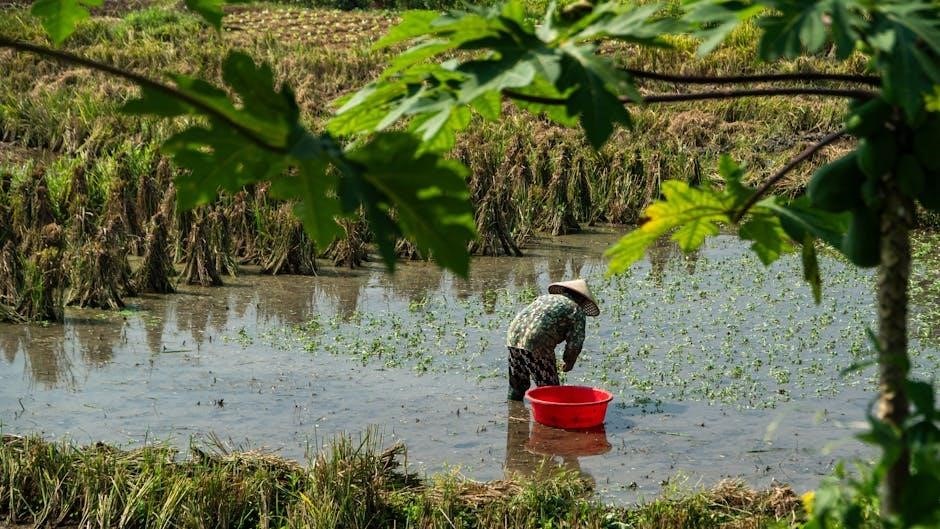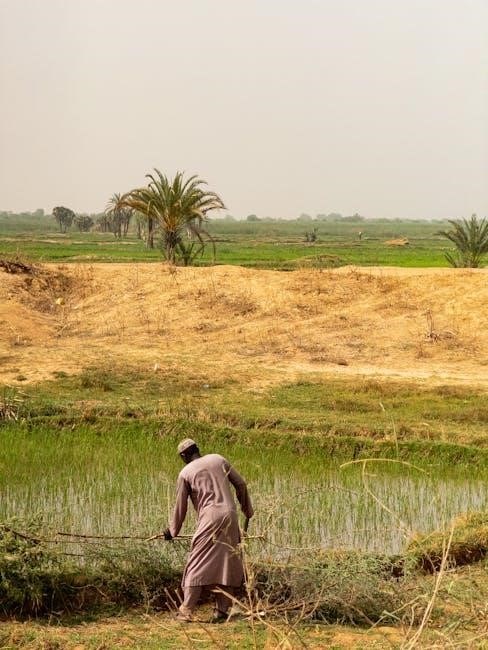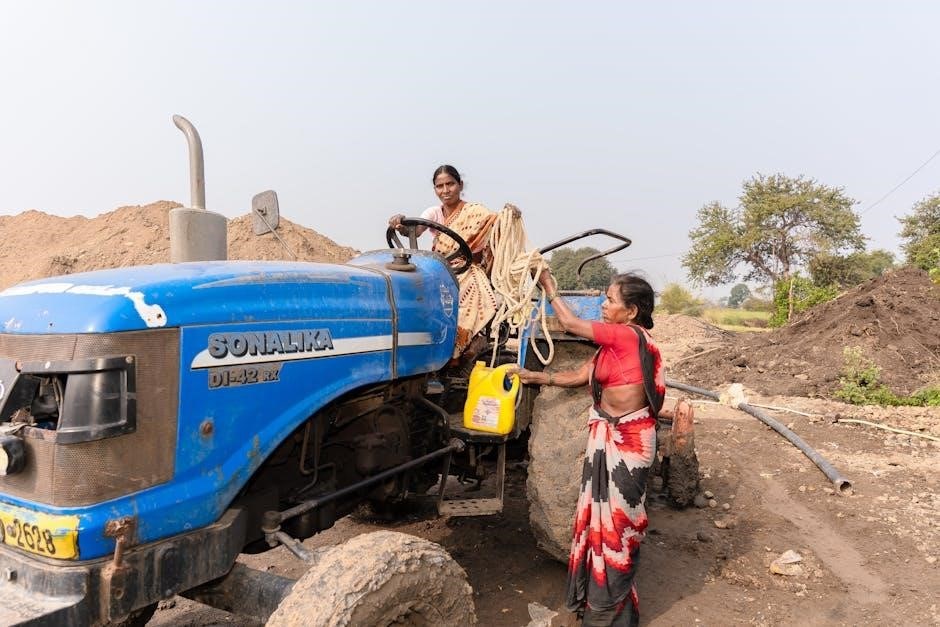Manual irrigation is a traditional method of water distribution, relying on human effort rather than automated systems. It involves delivering water directly to crops, ensuring efficiency and sustainability.
1.1 Definition and Overview
Manual irrigation refers to the practice of watering crops by hand or through non-mechanized systems, relying on human effort and simple tools. This method involves directly applying water to the soil, often using buckets, hoses, or basic distribution channels. It contrasts with automated irrigation, which uses advanced machinery. Manual irrigation is valued for its simplicity, cost-effectiveness, and ability to conserve water by delivering it precisely where needed. Despite its labor-intensive nature, it remains a vital technique, especially in small-scale farming and regions with limited resources.
1.2 Historical Context and Evolution
Manual irrigation traces its roots to ancient civilizations, where early farmers used rudimentary tools like buckets, canals, and hand-dug channels to water crops. Techniques evolved over centuries, with innovations such as shadufs (manual water-lifting devices) in Egypt and terraced irrigation in Asia. Despite advancements in technology, manual irrigation remains a cornerstone in many regions, blending traditional methods with modern adaptations to sustain agriculture. Its enduring relevance underscores its simplicity and effectiveness in resource-limited settings.
1.3 Importance in Agriculture and Water Management
Manual irrigation is vital for agriculture, enabling precise water delivery to crops, which enhances growth and reduces waste. It plays a crucial role in water conservation, especially in regions with limited resources. Small-scale farmers rely on manual methods to sustain livelihoods, as they are cost-effective and adaptable. By optimizing water use, manual irrigation supports environmental sustainability and food security, making it indispensable in many agricultural systems worldwide. Its simplicity ensures accessibility, even in areas with limited technological resources.

Types of Manual Irrigation Systems
Manual irrigation systems include surface, sprinkler, and micro-irrigation methods. These techniques vary in water application and distribution, catering to different agricultural needs and environments.
2.1 Surface Irrigation Methods
Surface irrigation involves water being distributed across the land by gravity or manual control. Common techniques include basin, furrow, and border irrigation. Basin irrigation floods a flat area, ideal for crops like rice. Furrow irrigation channels water between rows, suitable for row crops. Border irrigation floods strips of land, often used for orchards. These methods are labor-intensive but effective for small-scale farming, promoting water conservation and efficient crop watering. Regular monitoring ensures optimal water distribution and soil absorption.
2.2 Sprinkler and Micro-Irrigation Systems
Sprinkler and micro-irrigation systems are modern, efficient methods within manual irrigation. Sprinklers distribute water in a controlled spray pattern, mimicking natural rainfall. Micro-irrigation uses drippers or mini-sprinklers to deliver water directly to plant roots. Both methods reduce evaporation and runoff, enhancing water conservation. These systems are versatile, suitable for diverse crops and terrains. While they require initial setup, they offer long-term benefits in water efficiency and crop health. Regular maintenance ensures optimal performance and sustainability.
2.3 Water Application Techniques
Manual irrigation employs various water application techniques to optimize efficiency. Basin irrigation involves flooding a basin around plants, reducing runoff. Furrow irrigation uses channels between crop rows, directing water to roots. Manual watering with cans or hoses offers precision, ideal for small-scale farming. These methods ensure water is delivered directly to plants, minimizing waste and enhancing soil moisture retention. Proper technique selection depends on soil type, crop needs, and water availability, ensuring sustainable and effective irrigation practices.
Benefits of Manual Irrigation
Manual irrigation offers significant advantages, including precise water control, reduced waste, and lower operational costs. It promotes water efficiency and supports eco-friendly farming practices, enhancing crop health.
3.1 Water Conservation and Efficiency
Manual irrigation excels in water conservation by allowing precise control over distribution, reducing waste, and minimizing runoff. This method ensures that water is delivered directly to plant roots, optimizing absorption and minimizing evaporation. By targeting specific areas, farmers can avoid overwatering, preserving this vital resource. Its efficiency makes it particularly beneficial for small-scale agriculture, where water scarcity is a common challenge. This approach not only conserves water but also aligns with sustainable farming practices, promoting environmental stewardship.
3.2 Cost-Effectiveness for Small-Scale Farming
Manual irrigation is highly cost-effective for small-scale farming due to its low initial investment and minimal reliance on expensive machinery. It eliminates the need for complex infrastructure, making it accessible to farmers with limited resources. By focusing water delivery precisely where needed, it reduces waste and optimizes resource use. This method is particularly advantageous for small plots, allowing farmers to manage water and labor efficiently without significant upfront costs. It supports sustainable agriculture while maintaining affordability.
3.3 Environmental Sustainability
Manual irrigation promotes environmental sustainability by minimizing water waste and reducing the need for chemical inputs. It allows for precise water application, ensuring that plants receive only what is necessary, which helps conserve this vital resource. Additionally, manual methods avoid the energy consumption associated with automated systems, lowering carbon emissions. This approach also supports healthier soil structures and biodiversity, making it a eco-friendly choice for small-scale and traditional farming practices. It aligns with sustainable agriculture goals by preserving natural resources for future generations;

Key Components of Manual Irrigation
Manual irrigation systems rely on water sources, distribution tools, and soil-crop considerations. These elements ensure efficient water delivery, supporting plant growth and resource management effectively.
4.1 Water Sources and Storage
Manual irrigation relies on accessible water sources such as wells, rivers, and rainwater harvesting systems. Proper storage is essential to ensure a steady supply, often using ponds or tanks. These methods prevent water loss and contamination, maintaining quality for crops. Efficient storage solutions are critical, especially in water-scarce regions, to support consistent irrigation practices and sustainable agriculture.
4.2 Distribution Channels and Tools
Manual irrigation employs simple, low-cost tools like watering cans, buckets, and hand-operated pumps. Water is distributed through channels such as shallow ditches, canals, or direct pouring. These tools and methods ensure precise water delivery, reducing waste. While labor-intensive, they are effective for small-scale farming, allowing farmers to control water application accurately. This approach is particularly valuable in areas with limited access to advanced technology, supporting efficient crop growth and water conservation.
4.3 Soil and Crop Considerations
Manual irrigation requires careful consideration of soil type, structure, and crop water requirements. Soil properties like texture and organic matter influence water retention and penetration. Crops with varying root depths and water needs must be irrigated accordingly. For example, shallow-rooted plants need frequent, shallow watering, while deep-rooted crops require less frequent but deeper irrigation. Matching water application to soil and crop demands ensures efficient use of resources and optimal plant growth, minimizing waste and maximizing yield sustainability.

Challenges and Limitations
Manual irrigation faces challenges like labor intensity, time constraints, and water scarcity, requiring significant effort and resources to ensure efficient and consistent crop hydration.
5.1 Labor Intensity and Time Constraints
Manual irrigation demands significant labor, as farmers must manually operate tools and distribute water, often requiring long hours, especially during peak seasons. This labor-intensive process can lead to fatigue and reduced efficiency, impacting overall agricultural productivity. Time constraints further exacerbate the issue, as timely watering is crucial for crop health, making it challenging for small-scale farmers with limited workforce to manage effectively. This highlights the need for efficient labor management strategies to optimize water distribution and reduce workload.
5.2 Water Scarcity and Accessibility Issues
Water scarcity is a significant challenge in manual irrigation, particularly in arid regions where water sources are limited. Farmers often face difficulties in accessing sufficient water for their crops, leading to reduced yields and food insecurity. Additionally, the physical accessibility of water sources, such as wells or rivers, can be a barrier, especially in remote areas with inadequate infrastructure. These issues highlight the need for sustainable water management practices to ensure equitable access and efficient use of this vital resource.
5.3 Maintenance and Durability of Equipment
Manual irrigation systems often rely on basic, low-tech tools like watering cans, buckets, and hoses. However, these tools require regular maintenance to ensure durability and functionality. Issues like clogged nozzles, worn-out handles, or damaged pipes can hinder irrigation efficiency. Proper cleaning, storage, and timely repairs are essential to extend the lifespan of equipment. Neglecting maintenance can lead to equipment failure, increasing costs and labor efforts, which are critical challenges in manual irrigation systems.

Best Practices for Manual Irrigation
Adopt planning and scheduling to optimize water use. Regularly monitor soil moisture and plant needs. Integrate modern techniques like drip irrigation for enhanced efficiency and sustainability in manual systems.
6.1 Planning and Scheduling
Effective planning and scheduling are crucial for manual irrigation. Assess soil type, crop water requirements, and weather patterns to create a tailored watering plan. Divide tasks into manageable schedules to ensure consistent water distribution. Utilize calendars or apps to track irrigation sessions, preventing overwatering or neglect. Regular monitoring ensures adjustments can be made promptly, optimizing water use and crop health. This structured approach enhances efficiency and sustainability in manual irrigation systems.
6.2 Monitoring and Adjustment
Monitoring is essential in manual irrigation to ensure optimal water distribution. Regularly check soil moisture, crop condition, and water levels to identify any imbalances. Adjustments should be made based on weather patterns, soil type, and plant needs. For instance, increase watering during hot spells or reduce it after rain. Use tools like moisture meters or visual inspections to guide decisions. Timely adjustments prevent overwatering or underwatering, ensuring healthy plant growth and resource efficiency. This iterative process is key to sustainable manual irrigation practices.
6.3 Integration with Modern Techniques
Integrating manual irrigation with modern techniques enhances efficiency and sustainability. Sensors and IoT devices can monitor soil moisture and water levels, providing real-time data to inform manual watering decisions. Automation tools, such as smart valves, can be controlled remotely to complement manual efforts, ensuring consistent water delivery. These technologies reduce labor intensity while maintaining the precision of manual methods. By blending traditional practices with innovation, farmers can achieve better crop yields and water conservation, making manual irrigation more viable in contemporary agriculture.
Manual irrigation remains vital for sustainable agriculture, balancing tradition with modern innovations like sensors and automation to enhance water conservation and labor efficiency, ensuring future food security.
7.1 Summary of Key Points
Manual irrigation is a vital agricultural practice that emphasizes water conservation and efficiency, particularly beneficial for small-scale farming. It relies on traditional methods, reducing costs and environmental impact. By focusing on precise water delivery, it supports crop health and sustainability. Modern innovations, such as sensors and automation, are enhancing its effectiveness. Manual irrigation remains a cornerstone of sustainable agriculture, ensuring resource optimization and food security while maintaining ecological balance.
7.2 Innovations in Manual Irrigation
Innovations in manual irrigation are transforming traditional practices, enhancing efficiency and sustainability. Smart irrigation controllers, mobile apps, and IoT devices now enable precise water delivery. Solar-powered pumps and drip irrigation kits are reducing labor and water waste. Integration of sensors and automation tools optimizes scheduling and monitoring. These advancements are making manual irrigation more accessible and effective, ensuring better crop yields while conserving resources. Such innovations are pivotal in addressing global water challenges and supporting small-scale farming.
7.3 Role in Global Food Security
Manual irrigation plays a vital role in ensuring global food security by providing a reliable method of water distribution, especially in regions with limited resources. It empowers small-scale farmers to cultivate crops efficiently, contributing to local food production and reducing dependency on industrial systems. By optimizing water use and improving crop yields, manual irrigation helps meet the increasing demand for food while addressing challenges like water scarcity and climate change, ensuring sustainable agriculture for future generations.